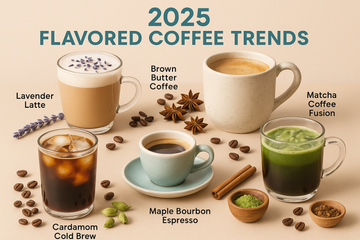Discover the latest innovations and emerging flavors transforming the coffee industry this year
The flavored coffee landscape is experiencing a remarkable transformation in 2025, with innovative brewing techniques, exotic flavor profiles, and sustainable practices reshaping how we experience our daily cup. From artisanal botanical infusions to cutting-edge fermentation methods, coffee enthusiasts are embracing bold new directions that push beyond traditional boundaries.
Botanical and Floral Infusions Lead the Way
Floral notes have emerged as the dominant trend, with lavender, rose, and hibiscus creating sophisticated flavor profiles that appeal to discerning palates. These botanical infusions offer a delicate complexity that transforms ordinary coffee into an aromatic experience reminiscent of fine tea ceremonies.
Elderflower coffee blends are gaining particular traction, providing a subtle sweetness that complements medium roast beans beautifully. The key to successful floral integration lies in precise timing during the roasting process, where natural flower essences are introduced at optimal temperature points to preserve their delicate characteristics.
Jasmine-infused varieties are creating waves among specialty coffee shops, offering an exotic alternative to traditional vanilla and caramel options. The jasmine's natural perfume enhances the coffee's inherent aromatics without overwhelming the bean's original flavor profile.
Fermented Flavor Innovations
Fermentation techniques borrowed from wine and kombucha production are revolutionizing flavored coffee creation. These methods develop complex flavor compounds naturally, creating depth and character that artificial flavoring cannot replicate.
Controlled fermentation processes allow coffee producers to introduce fruit flavors like passion fruit, guava, and dragon fruit during the green bean stage. This approach results in more integrated flavoring that permeates the entire bean rather than coating the surface.
Wild fermentation, where naturally occurring yeasts and bacteria influence flavor development, is producing unique regional variations. Each batch develops distinct characteristics based on local environmental factors, creating truly artisanal products that reflect their terroir.
Dessert-Inspired Flavor Profiles
Dessert flavors are evolving beyond simple sweet additions to encompass complex pastry-inspired profiles. Tiramisu coffee blends combine mascarpone cream notes with cocoa undertones, creating an authentic Italian dessert experience in liquid form.
Crème brûlée flavored varieties feature caramelized sugar notes balanced with vanilla bean complexity. These sophisticated profiles require careful bean selection, typically utilizing medium-dark roasts that can support the rich flavor additions without becoming overpowering.
Seasonal dessert flavors are gaining momentum, with pumpkin spice evolving into more nuanced autumn blends featuring maple, cinnamon bark, and nutmeg. Winter varieties incorporate peppermint bark, eggnog, and gingerbread elements that capture holiday nostalgia.
Global Spice Integration
International spice blends are introducing coffee drinkers to flavor combinations from diverse culinary traditions. Cardamom and rose water combinations inspired by Middle Eastern cuisine create exotic morning rituals that transport drinkers to distant lands.
Indian masala chai influences are appearing in coffee blends, featuring ginger, cloves, black pepper, and star anise. These warming spices complement coffee's natural bitterness while adding layers of complexity that evolve with each sip.
Mexican chocolate inspirations incorporate cinnamon, chili powder, and vanilla, creating bold flavor profiles that balance heat with sweetness. These combinations work particularly well with dark roast beans that can stand up to the intense spice additions.
Natural Sweetening Alternatives
The movement away from artificial sweeteners has sparked innovation in natural flavor enhancement. Monk fruit extract provides sweetness without calories while contributing subtle fruity undertones that complement coffee's natural acidity.
Date syrup infusions offer caramel-like sweetness with mineral complexity that enhances rather than masks coffee flavors. This approach appeals to health-conscious consumers seeking indulgent experiences without refined sugar.
Coconut palm sugar integration during the roasting process creates naturally sweet beans with tropical undertones. The sugar caramelizes during roasting, creating complex flavor compounds that provide sustained sweetness throughout the brewing process.
Cold Brew Flavor Innovations
Cold brewing methods are opening new possibilities for flavor infusion, with extended steeping times allowing for deeper flavor penetration. Citrus oils extracted during cold brewing create bright, refreshing profiles perfect for warm weather consumption.
Nitrogen infusion techniques are being combined with flavored cold brews to create creamy textures that enhance flavor perception. The nitrogen's smooth mouthfeel allows subtle flavors to shine while creating an indulgent drinking experience.
Fruit-forward cold brews featuring berry medleys, stone fruit combinations, and tropical blends are replacing traditional iced coffee options. These refreshing alternatives appeal to younger demographics seeking Instagram-worthy beverages with complex flavor profiles.
Sustainable Flavor Sourcing
Environmental consciousness is driving demand for sustainably sourced flavor ingredients. Direct trade relationships with vanilla growers, spice farmers, and botanical suppliers ensure ethical sourcing while maintaining flavor quality.
Upcycled flavor ingredients made from food waste are gaining acceptance among environmentally aware consumers. Orange peel oils recovered from juice production and vanilla extracted from spent pods demonstrate creative sustainability approaches.
Local sourcing initiatives are creating regional flavor profiles that reflect local agricultural products. These partnerships support local farmers while creating unique flavor combinations that cannot be replicated elsewhere.
Brewing Method Optimization
Different brewing methods are being optimized for specific flavor profiles, with pour-over techniques highlighting delicate floral notes while French press methods enhance bold spice flavors. Understanding these relationships helps consumers maximize their flavored coffee experience.
Espresso-based flavored drinks are incorporating flavor syrups made from natural ingredients rather than artificial alternatives. These premium syrups provide authentic taste experiences that complement rather than compete with espresso's intensity.
Temperature control during brewing is becoming increasingly important for flavored varieties, with specific temperature ranges optimal for different flavor compounds. Lower temperatures preserve delicate floral notes while higher temperatures extract robust spice flavors effectively.
Consumer Education and Appreciation
Coffee education programs are helping consumers understand flavor complexity and appreciate artisanal craftsmanship. Cupping sessions focused on flavored varieties teach participants to identify subtle notes and understand flavor development processes.
Pairing recommendations that match specific flavored coffees with complementary foods are enhancing the overall experience. These suggestions help consumers create memorable moments that extend beyond simple caffeine consumption.
The flavored coffee renaissance of 2025 represents a maturation of consumer palates and producer capabilities, creating opportunities for both innovation and appreciation of traditional craftsmanship in this evolving industry.






